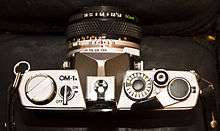Olympus OM-1
 OM-1MD with 50 mm f/1.8 lens | |
| Overview | |
|---|---|
| Maker | Olympus Optical Co., Ltd |
| Type | SLR |
| Lens | |
| Lens mount | Olympus OM mount |
| Sensor/Medium | |
| Recording medium | 135 film |
| Focusing | |
| Focus | Manual focus |
| Exposure/Metering | |
| Exposure | Manual |
| Flash | |
| Flash | Hot shoe |
| Shutter | |
| Frame rate | manually wound |
| Shutter speed range | 1 s – 1/1000 s; Bulb |
| General | |
| Dimensions | 136 × 83 × 50 mm |
| Weight | 510 g (18 oz) |
| Footnotes | |
| [1][2] | |
The Olympus OM-1 is a manually operated 35mm single-lens reflex camera. It is part of the Olympus OM system.
History
The first model was presented at photokina in Cologne in 1972 and was called the Olympus M-1. Thirteen years earlier, the release of the Nikon F had made the 35 mm SLR the standard choice for professionals accustomed to Leica and other rangefinders, but it had driven the market towards heavy and bulky cameras. The Olympus M-1 changed this and with it began a reduction of size, weight and noise of the 35 mm SLRs. It was designed by a team led by Yoshihisa Maitani, who had already created the Pen and Pen F cameras, noted for their compactness.

Since Leica's flagship rangefinder cameras are known as the M Series, Leica complained about the name of the M-1, forcing Olympus to rename it as the OM-1 to further clarify between the brands. Because of this, today bodies and lenses with the original M name are rare (52000 bodies were made according to Olympus) and sought after by collectors.
The OM-1 is an all-mechanical SLR. It has a large viewfinder with interchangeable screens but a fixed prism. It also has a through-the-lens exposure meter controlling a needle visible in the viewfinder. It has a compact body, essentially retained on later models. The shutter speed dial is located around the lens mount, which allows photographers to keep the camera at the eye between shots more easily than SLRs with the dial located on the top plate.

Originally, the bottom plate needed to be modified to mount a motor drive on the OM-1. In 1974, Olympus launched the OM-1MD (MD standing for Motor Drive), to which a motor drive can be attached without need for modification. This new version has a small plate marked 'MD' on the front, and a small slot with a circular cover on the underside that covers the motor drive coupling.
The OM-1n is similar to the OM-1MD, with a redesigned film advance lever, a flash ready/sufficient flash LED in the viewfinder, and automatic flash synchronization (X-sync), regardless of the position of the FP/X switch when used with a T-series flash unit mounted on Flash Shoe 4.
References
- ↑ "Olympus OM-1". Guide to Classic Cameras. mediajoy. Retrieved 3 March 2012.
- ↑ Ting, Ed (23 June 2008). "Olympus OM1 and OM2 Overview". Retrieved 3 March 2012.
- Foo, Leo (2000). "Modern Classic SLRs Series: Olympus OM-1(n)". Photography in Malaysia. Retrieved 16 December 2005.
- Axford, Robert Ian. "Olympus OM-1 shutter". Robert Ian Axford's Camera-Works. Retrieved 16 December 2005.
External links
![]() Media related to Olympus OM-1 at Wikimedia Commons
Media related to Olympus OM-1 at Wikimedia Commons
- Olympus History : OM Series Olympus Corporation History Page.
- Olympus M-1 User review and further details.
This article was originally based on "Olympus_OM-1/2/3/4" in Camerapedia, retrieved on 26 May 2006 under the GNU Free Documentation License.